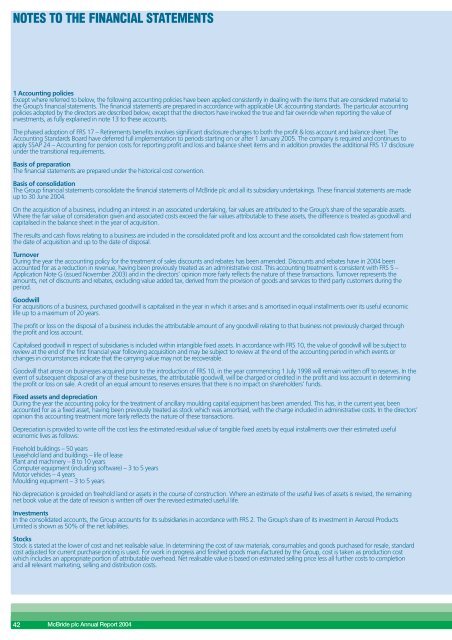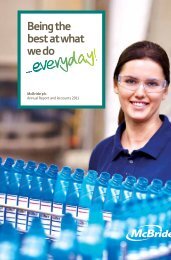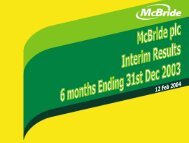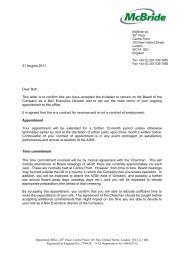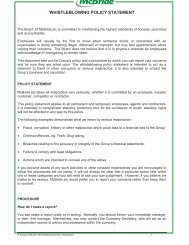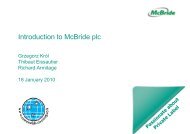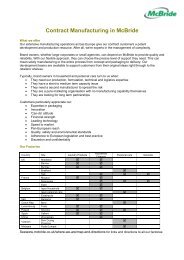pdf (2MB) - McBride
pdf (2MB) - McBride
pdf (2MB) - McBride
Create successful ePaper yourself
Turn your PDF publications into a flip-book with our unique Google optimized e-Paper software.
NOTES TO THE FINANCIAL STATEMENTS1 Accounting policiesExcept where referred to below, the following accounting policies have been applied consistently in dealing with the items that are considered material tothe Group’s financial statements. The financial statements are prepared in accordance with applicable UK accounting standards. The particular accountingpolicies adopted by the directors are described below, except that the directors have invoked the true and fair over-ride when reporting the value ofinvestments, as fully explained in note 13 to these accounts.The phased adoption of FRS 17 – Retirements benefits involves significant disclosure changes to both the profit & loss account and balance sheet. TheAccounting Standards Board have deferred full implementation to periods starting on or after 1 January 2005. The company is required and continues toapply SSAP 24 – Accounting for pension costs for reporting profit and loss and balance sheet items and in addition provides the additional FRS 17 disclosureunder the transitional requirements.Basis of preparationThe financial statements are prepared under the historical cost convention.Basis of consolidationThe Group financial statements consolidate the financial statements of <strong>McBride</strong> plc and all its subsidiary undertakings. These financial statements are madeup to 30 June 2004.On the acquisition of a business, including an interest in an associated undertaking, fair values are attributed to the Group’s share of the separable assets.Where the fair value of consideration given and associated costs exceed the fair values attributable to these assets, the difference is treated as goodwill andcapitalised in the balance sheet in the year of acquisition.The results and cash flows relating to a business are included in the consolidated profit and loss account and the consolidated cash flow statement fromthe date of acquisition and up to the date of disposal.TurnoverDuring the year the accounting policy for the treatment of sales discounts and rebates has been amended. Discounts and rebates have in 2004 beenaccounted for as a reduction in revenue, having been previously treated as an administrative cost. This accounting treatment is consistent with FRS 5 –Application Note G (issued November 2003) and in the directors’ opinion more fairly reflects the nature of these transactions. Turnover represents theamounts, net of discounts and rebates, excluding value added tax, derived from the provision of goods and services to third party customers during theperiod.GoodwillFor acquisitions of a business, purchased goodwill is capitalised in the year in which it arises and is amortised in equal installments over its useful economiclife up to a maximum of 20 years.The profit or loss on the disposal of a business includes the attributable amount of any goodwill relating to that business not previously charged throughthe profit and loss account.Capitalised goodwill in respect of subsidiaries is included within intangible fixed assets. In accordance with FRS 10, the value of goodwill will be subject toreview at the end of the first financial year following acquisition and may be subject to review at the end of the accounting period in which events orchanges in circumstances indicate that the carrying value may not be recoverable.Goodwill that arose on businesses acquired prior to the introduction of FRS 10, in the year commencing 1 July 1998 will remain written off to reserves. In theevent of subsequent disposal of any of these businesses, the attributable goodwill, will be charged or credited in the profit and loss account in determiningthe profit or loss on sale. A credit of an equal amount to reserves ensures that there is no impact on shareholders’ funds.Fixed assets and depreciationDuring the year the accounting policy for the treatment of ancillary moulding capital equipment has been amended. This has, in the current year, beenaccounted for as a fixed asset, having been previously treated as stock which was amortised, with the charge included in administrative costs. In the directors’opinion this accounting treatment more fairly reflects the nature of these transactions.Depreciation is provided to write off the cost less the estimated residual value of tangible fixed assets by equal installments over their estimated usefuleconomic lives as follows:Freehold buildings – 50 yearsLeasehold land and buildings – life of leasePlant and machinery – 8 to 10 yearsComputer equipment (including software) – 3 to 5 yearsMotor vehicles – 4 yearsMoulding equipment – 3 to 5 yearsNo depreciation is provided on freehold land or assets in the course of construction. Where an estimate of the useful lives of assets is revised, the remainingnet book value at the date of revision is written off over the revised estimated useful life.InvestmentsIn the consolidated accounts, the Group accounts for its subsidiaries in accordance with FRS 2. The Group’s share of its investment in Aerosol ProductsLimited is shown as 50% of the net liabilities.StocksStock is stated at the lower of cost and net realisable value. In determining the cost of raw materials, consumables and goods purchased for resale, standardcost adjusted for current purchase pricing is used. For work in progress and finished goods manufactured by the Group, cost is taken as production costwhich includes an appropriate portion of attributable overhead. Net realisable value is based on estimated selling price less all further costs to completionand all relevant marketing, selling and distribution costs.42<strong>McBride</strong> plc Annual Report 2004


